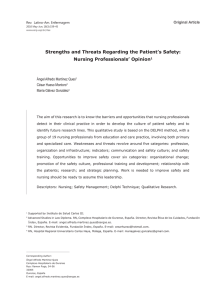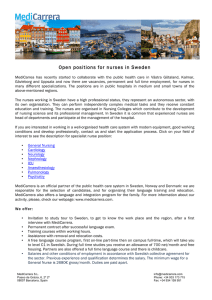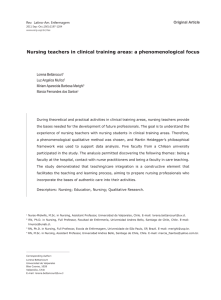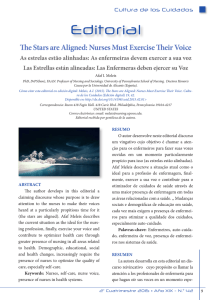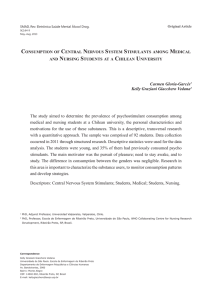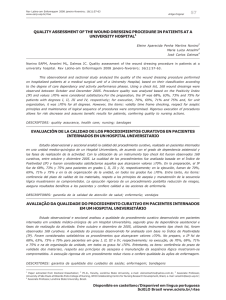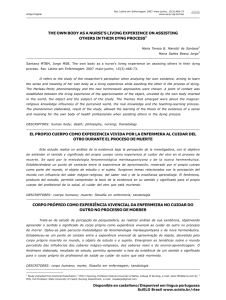Human resources management and its interface in the
Anuncio
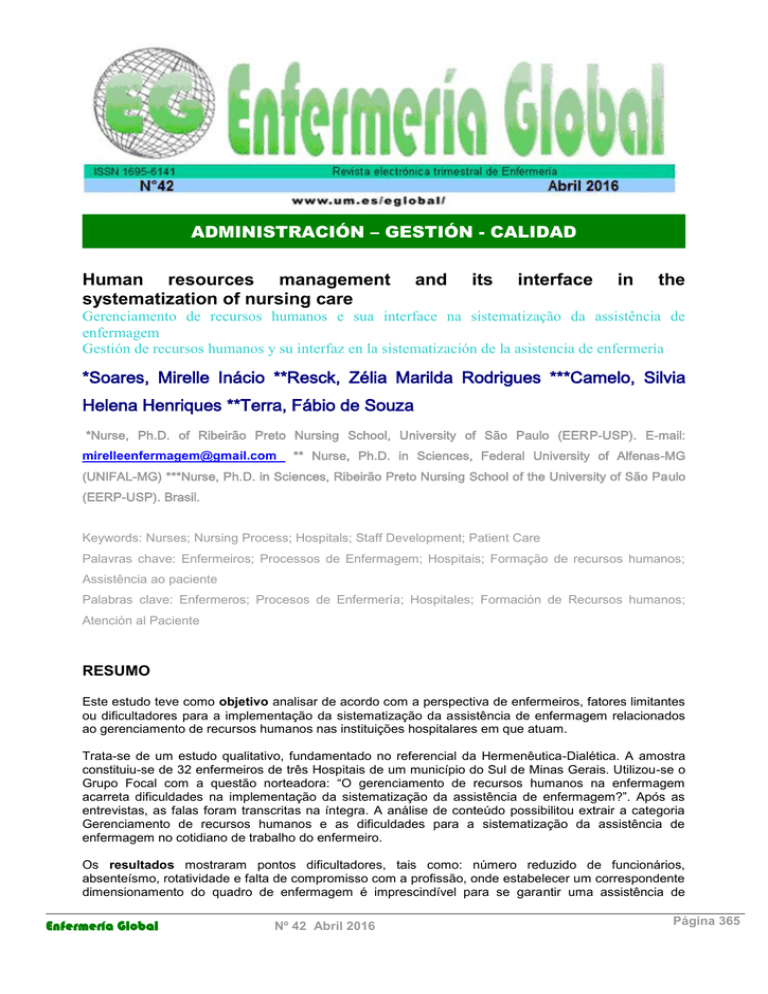
ADMINISTRACIÓN – GESTIÓN - CALIDAD Human resources management systematization of nursing care and its interface in the Gerenciamento de recursos humanos e sua interface na sistematização da assistência de enfermagem Gestión de recursos humanos y su interfaz en la sistematización de la asistencia de enfermería *Soares, Mirelle Inácio **Resck, Zélia Marilda Rodrigues ***Camelo, Silvia Helena Henriques **Terra, Fábio de Souza *Nurse, Ph.D. of Ribeirão Preto Nursing School, University of São Paulo (EERP-USP). E-mail: [email protected] ** Nurse, Ph.D. in Sciences, Federal University of Alfenas-MG (UNIFAL-MG) ***Nurse, Ph.D. in Sciences, Ribeirão Preto Nursing School of the University of São Paulo (EERP-USP). Brasil. Keywords: Nurses; Nursing Process; Hospitals; Staff Development; Patient Care Palavras chave: Enfermeiros; Processos de Enfermagem; Hospitais; Formação de recursos humanos; Assistência ao paciente Palabras clave: Enfermeros; Procesos de Enfermería; Hospitales; Formación de Recursos humanos; Atención al Paciente RESUMO Este estudo teve como objetivo analisar de acordo com a perspectiva de enfermeiros, fatores limitantes ou dificultadores para a implementação da sistematização da assistência de enfermagem relacionados ao gerenciamento de recursos humanos nas instituições hospitalares em que atuam. Trata-se de um estudo qualitativo, fundamentado no referencial da Hermenêutica-Dialética. A amostra constituiu-se de 32 enfermeiros de três Hospitais de um município do Sul de Minas Gerais. Utilizou-se o Grupo Focal com a questão norteadora: “O gerenciamento de recursos humanos na enfermagem acarreta dificuldades na implementação da sistematização da assistência de enfermagem?”. Após as entrevistas, as falas foram transcritas na íntegra. A análise de conteúdo possibilitou extrair a categoria Gerenciamento de recursos humanos e as dificuldades para a sistematização da assistência de enfermagem no cotidiano de trabalho do enfermeiro. Os resultados mostraram pontos dificultadores, tais como: número reduzido de funcionários, absenteísmo, rotatividade e falta de compromisso com a profissão, onde estabelecer um correspondente dimensionamento do quadro de enfermagem é imprescindível para se garantir uma assistência de Enfermería Global Nº 42 Abril 2016 Página 365 excelência à clientela. No entanto, para o sucesso da operacionalização da sistematização da assistência de enfermagem é necessário considerar o número do pessoal de enfermagem, a complexidade de assistência requerida pelos pacientes e ainda vencer a resistência por parte de alguns enfermeiros que ainda não compreendem a sistematização da assistência de enfermagem como respaldo legal da profissão. RESUMEN Este estudio tuvo como objetivo analizar de acuerdo a la perspectiva de las enfermeras, los factores o dificultades que limitan la aplicación de sistematización de la asistencia de enfermería relacionados con la gestión de recursos humanos en los hospitales donde trabajan. Se trata de un estudio cualitativo, basado en el marco de la hermenéutica-dialéctica. La muestra estuvo conformada por 32 enfermeras de tres hospitales en una ciudad en el sur de Minas Gerais. Se utilizó el grupo focal con la pregunta guía: "¿La gestión de los recursos humanos en enfermería conlleva dificultades en la implementación de la sistematización de la atención de enfermería?". Después de las entrevistas, los discursos fueron transcritos totalmente. El análisis de contenido permitió extraer la gestión de categorías de los recursos humanos y las dificultades para la sistematización de la asistencia de enfermería en el trabajo diario de enfermería. Los resultados mostraron que puntos de dificultad tales como: reducción del número de empleados, el absentismo, la rotación y la falta de compromiso con la profesión, donde establecer un dimensionado correspondiente del marco de enfermería es esencial para asegurar la excelencia de la asistencia al cliente. Sin embargo, para la puesta en marcha con éxito de la sistematización de la asistencia de enfermería es necesario tener en cuenta el número de personal de enfermería, la asistencia de la complejidad requerida por los pacientes e incluso superar la resistencia de algunas enfermeras que todavía no entienden la sistematización de la asistencia de enfermería como un respaldo legal de la profesión. ABSTRACT This study aimed to analyze according to the perspective of nurses, limiting factors or difficulties to the implementation of systematization of nursing care related to human resources management in the hospital institutions where they work. This is a qualitative study, based on the reference of Hermeneutics-Dialectics. The sample consisted of 32 nurses from three Hospitals in a city in southern Minas Gerais. The Focus Group was used, with the following guiding question: “Does the management of human resources in nursing brings on difficulties in implementing the systematization of nursing care?” After the interviews, the speeches were fully transcribed. The content analysis enabled to extract the category Management of human resources and the difficulties for the systematization of nursing care in nursing daily work. The results showed hindering points, such as: reduced number of employees, absenteeism, turnover and lack of commitment to the profession, where establishing a corresponding dimensioning of the nursing framework is essential to ensure the excellence of customer assistance. However, for the successful operationalization of the systematization of nursing care is necessary to consider the number of nursing staff, the complexity of assistance required by patients, and also overcome resistance by some nurses who do not yet understand the systematization of nursing care as a legal profession support. INTRODUCTION Currently, the biggest challenge pointed out in the context of the health sector is the process of reorganization of hospital institutions; about ensure distribution and use of human, financial and material resources that consider the effectiveness, efficiency and economic viability of the health system (1). The development and significant changes in occupational environments related to technological innovation and changes in work organization emerge new business logic that seeks to value the human factor in organizations associated with technological Enfermería Global Nº 42 Abril 2016 Página 366 development. In this context, Nursing is seen as a profession focused on interactions in which each human being, by experiencing a health project, becomes singular, unique and indivisible in a unique moment of care (2). It is observed a lack of commitment to health organizations with the development of its human capital, where the precariousness of work and service conditions in hospital institutions, contribute to the high level of uncertainty in everyday Nursing practice, such as: the high turnover of workers; high absenteeism; permanent insufficient equipment; the lack of consumables needed to care, among others; which requires urgent adjustments in the management model of these institutions (3). In the process of the nursing work, especially in the hospital environment, nurses have assumed care of the most severely ill patients, in addition to organizing activities and coordination of services, developing, in a participatory manner, the management and care activities (4). The nurse in the hospital environment develops numerous tasks with high demands and responsibilities, which depending on how they are organized and their knowledge about management tools to assist them, can facilitate or hinder the quality of care. In this sense, the Systematization of Nursing Assistance (SAE) is a management tool in nursing that can facilitate the work process since the nurse as a team and unit manager should use tools or strategies that enable to answer the professional goals of the institution, and the SAE has responded to this demand. However, it is necessary all nursing staff being involved in this process. The use of tools such as SAE should have adherence of all staff involved, thus bringing contributions for assistance. Thereby, this study presents the following questions: Which are the challenges and/or limitations that go through the nurse's daily work as manager of the team, in implementing the SAE? Could strategies or tools in the management of human resources, help nurses in implementing the SAE? The performance of this study is justified in order to contribute to the reflection of nursing professionals and hospital managers about the need for professionals able to this function, that have autonomy and seek their space using various management tools in an attempt to break the dichotomy between what is recommended and what is done in the daily nursing, contributing to the planning and organization of the management and care practice. Thus, the objective of this research was to analyze according to the nurses perspective, limiting factors or difficulties to the implementation of SAE related to human resources management in hospitals where they work. MATERIAL AND METHOD It is a study of exploratory design, with qualitative approach, anchored in the theoretical and methodological framework of Hermeneutics-Dialectics, considered a method of empirical research, which reveals a belief in the process of moving there permanently in society, and in the historic building and the ability to transform and overcome contradictions through the praxis (5). The development of this research field was the nurses' performance scenario, consisting of three Hospitals in a city in southern Minas Gerais, being two publics, one Enfermería Global Nº 42 Abril 2016 Página 367 educational and one private. 85 nurses of these institutions were invited to participate in the research, and the invitations made via invitation letter, via telephone and electronics. Given this opportunity, the research objectives were presented, the relevance of adherence, the performance of this research, the guarantee of anonymity, seeking to ease the concern of any future exposure. It is important to emphasize that the return of these participants was partial, attending the scheduled hours and days, by agreement of the guests, only those who agreed to participate in this survey. To collect the empirical material was elected the focus group technique, using digital recorders for the registration of speeches of the participants with the following guiding question: “Does the management of human resources in nursing entails difficulties in implementing the SAE?” In the developing work together to focus groups, 32 nurses from 85 guests were part of the sample, since according to the Sizing of each hospital Nurses, six meetings were held, where there was a focus group of four nurses in private hospital in December 2012, two focus groups in the public hospital in January 2013, and the two groups performed, both consisted of seven nurses and three focus groups in public teaching hospital in February 2013, and the first group consisted of five nurses, the second of four nurses and the third of five nurses. It is noteworthy that each focus group was performed at the required hospital institution, where groups were conducted consecutively and were organized according to periods of work, i.e., morning, afternoon and evening shift, and the availability of each nurse to participate in focus groups. It is clear to emphasize that the participants belonging to each focus group were identified by the letter N to the nurse, and received a sequential numbering in Arabic numerals, guaranteeing thus, the anonymity of speech. Thus they were referenced E1 to E32. The Research Ethics Committee (REC) of the Federal University of Alfenas (UnifalMG), Opinion nº. 139,518 in 11/05/2012, CAAE 08899312.8.0000.5142, approved this study. Nurses signed the Informed Consent (IC), as recommended by the National Council of Health Resolution (CNS) 466/12 (6). To analyze the data, the content analysis technique proposed by Minayo (7) was used, constituting three basic phases: pre-analysis, material exploration, and treatment of results. The pre-analysis is considered the organizational phase of the study, with the first step in organizing the data collected in the focus groups, conducted with participants of the study, preceding the transcription from digital recorders, respecting the speeches in full. The phase named material exploration is the analysis, in the case of a large time of the study, since it requires a movement of coming and going of speeches to explore the available material in depth. The phase called treatment of the results allows the researcher to propose inferences and perform subsequent interpretations foreshadowed in the theoretical framework, seeing new fronts, providing the basis for another analysis, alluded by material reading for new theoretical dimensions, performed by the method of Hermeneutics-Dialectics. Enfermería Global Nº 42 Abril 2016 Página 368 RESULTS AND DISCUSSION To better emphasize the understanding of the empirical category study, the characterization of the participants was made, noting that all nurses are responsible for industries units of small, medium and large complexity. Among these, females predominated, aged between 20-40 years old. Thus, the data showed professionals with some Sensu Lato Postgraduate and only one nurse had Stricto Sensu PostGraduation. The service ranged from one year to 25 years in the profession, 10 of these nurses were graduates of public institutions and 22 private institutions. Concerning the 32 nurses participating in the study, ten were nursing technicians before completing the Nursing Degree; two nurses have over 20 years graduated; seven have 10 years graduated, and 23 between one to ten years graduated. Thus, arose one big category “Human Resources Management and the SAE difficulties in the nursing daily work”, from qualitative data. Human resources management and the difficulties for the SAE in the nursing daily work. The responsibility of nursing services managers to ensure the quality of services to customers and working conditions to its professional team, have been inhibited both by the number disability of employees and by the deficit composition of the nursing team. Thus, this difficulty, shared by nurses class around the world, impels the enterprise efforts to develop and support measures to assist the managers of health institutions, government agencies, and society to understand the meaning involving nursing professionals framework (8). In this study, by E1 nurse's testimony it is understood that he can perceive the need for the hospital administration to prioritize the management of the nursing staff and to recognize the role and importance of nurses in leadership team: In contrast, I see that we have a human resources problem, because sometimes they do not recognize the real need for you to ask one more employee [...] sometimes, because you will have a nurse the whole night [...] they think that nurses will not do anything, because who medicates is the technician, who changes is technical, who changes position is the technical, but those who plan, who gives the support? (N1) In the health sector scenario, it is possible to identify a historical neglect and even an absence of policies for human resources (PHR), which may occur due to macroeconomic approaches that focus on quantitative aspects of the health sector workforce, rather than a contemporary approach at micro level, that focuses on motivation, performance and no appreciation of the professional role more than with political and operational goals of the health care system (9). In this sense, the quality of nursing care presupposes the quantitative and qualitative adequacy of the nursing staff members, investment in their training and offering working conditions that enable the proper exercise of its functions and meet the needs and customer expectations (10). The question whether health facilities are ready and interested in increasing its nurses framework enough to ensure the effective implementation of the SAE (11), was evidenced in the speech of N26 nurse: Enfermería Global Nº 42 Abril 2016 Página 369 [...] Our will to improve care is very big [...] it is only little by little, sometimes happens [...] depending on duty, there is no employee, sometimes the nurse don’t stay only in one sector, but in many sectors, it turns out that [...] most of the time the nurse ends up doing the work of the technical [...] (N26) The sizing of the nursing staff shall be estimated by the use of instruments, considering the various performed activities and assisting in real quantification of nursing workload and determining the number of workers to compose the team (12), referenced by N14 nurse: [...] Here is wrong, if we make that account, that table we learned is not even the half. Thus, the percentage distribution of all nursing professionals is essential, as the Resolution (13). Considering the following proportions: minimal and intermediate care: 33% to 37% of nurses (minimum of six) and 73% of technicians and nursing assistants; semi-intensive care: 42% to 46% of nurses and others, technicians and nursing assistants; intensive care: 52% to 56% of nurses and others, nursing technicians (8). It was unveiled in the N15's testimony: [...] I do not know in ward yet, I do not know if there is an employee proportion for bed. CTI has, Dialysis has, Oncology I do not know, but well, I do not know if there is in this ward, we know it's still difficult [...] (N15) From these notes, the limited number of nursing professionals, fragmentation, lack of time, lack of interest, poor involvement of nursing professionals and the link with health institutions are also limiting factors in the operation of SAE (14). What also happens, sometimes, is when the employee number is also not enough, and then the nurse ends up making the function of the employee and he can not at all make a systematization because he has to make the activity of others to help [...] (N14) The implementation of SAE requires more than will and dedication of nurses, but the institutional support that enables the reorganization of the service, the allocation of human resources and material, prioritizing thus assistance (15). The lack of interest of managers, supervisors, and institutions with a bureaucratic organization does not expect other care unless the established by the medical profession, to maximize resources and reduce costs. And if the SAE deploying proposal does not comply with the mission, with culture, philosophy and the objectives of the institution, this can not only prevent its implementation but also result in failure (16). This is a reality unveiled in the empirical setting of this study, as the testimonies of nurses: [...] That part of human resources I still feel that private institutions are stronger, increase the number of frames [...] let us more served in care [...] (N1) [...] Doing our job that I think everyone would love because the systematization would greatly improve the quality of care, we would need to have this, would have employees to be carrying out their activities so we Enfermería Global Nº 42 Abril 2016 Página 370 could do our [...] we are still walking, but slow in number of people, employees. (N15) [...] I think the first step of this systematization is human resources [...] (N16) [...] We recognize the importance, knows the importance, know that facilitates our work, organizing, but by institutional philosophy, by number issues, sizing employees [...] (N23) The heavy workload, insufficient staff framework, and factors inherent in the management of the institution, reflect commonly in the form of acting of nurses, adopting these mechanized actions, repetitive and strictly bureaucratic, and with little attention to the individual characteristics of each patient (17). [...] During some duty you make a lot of things, you've been there, here, did this, did that, did part of so many people, that at the end you sit, you talk, and seems I did not do anything. (N24) I think there's not such a good declared function division, one is quite a bit of everything and at the end is nothing, this is the truth when you delegates too much, you do not do anything [...] (N27) The constant search for personnel management process in nursing is part of the health service aimed at increasing the satisfaction of its employees so that motivated, to perform their tasks efficiently and effectively. However, the practice of nursing has many dissatisfactions presented by nurses related to lack of employees and the workload for better performance concerning the SAE as a team leader (18). This reality is evidenced by the speech of N19 nurse: [...] I say that is human caring human, look for the same workload, the salary issue, the issue of two jobs, three, is one of the main flows, and then it is a set, they are human beings, each one in a different evolutionary scale, with different capacity [...] (N19) The precariousness of work in public health institutions has also been a constant face of rising demand of attendance parallel to the insufficient of financial resources available to the health (19). In this precariousness context, the lack of time in nursing services is cited, which operate with a contingent beneath of the needs to meet a growing demand from patients. However, to the nurse fulfill its role, it is necessary primarily, a readjustment in the number of available professionals (15), as evidenced by the following statements: Time is scarce when we think no, but even working in 12 hours shift they don’t have time to make systematization for each patient, it is impossible, in one sector would be possible. (N15) When you are in one sector, it is much easier to work [...] when you have working condition, fewer patients; you execute your work much better. (N16) [...] There are days when I can not assess, I prescribe, but I can not assess the result [...] how you make systematization [...] there is anyone to cover holidays, there is nothing [...] how is the systematization [...] (N27) Enfermería Global Nº 42 Abril 2016 Página 371 It is noteworthy that an overloaded staff, even if motivated, will generate a drop in production, quality and negative implications for the institution, as well as calling into question the customer dissatisfaction that will be attended by an unsatisfied and tired professional (20). It adds to this analysis that the resizing benefits from the team are not limited to the patient sphere, but also cover professional dimension through the rescue of the humanistic values of nursing care and institutional. Thus, hospitals, which aim the excellence of the service, have better credibility in its image in the community and increased competition in health care (21). It is important to highlight that the increase of contingent nursing staff, will not guarantee improved productivity and excellence in quality of care. This increase should be preceded by a systematic review of the work process, eliminating activities that add little value and are unnecessary or even redundant to the patient and which require staff time. Thus, there must be firm commitment of nurses in the analysis of flow and working practices and in redesigning this process when necessary (21). It is observed that excessive workload is one of the stressful points most cited by study participants for non-implementation of SAE. Adding to these notes, to include a Human Resources consultancy in a hospital, is a compelling and very effective tool, since people management is not only to control the salary remuneration processes, benefits, labor standards or numbers of people working within the institution but also to analyze the organizational and behavioral environment of its employees and managers. However, for optimal organizational management, it has to be considered their satisfaction because the recognition is obtained by them (20). Thus, the low participation in specific nursing courses can allude that the time that these professionals possess is scarce to dedicate to other activities such as courses for training and qualification, happening probably from physical fatigue, stress, availability of time and the lack of stimulus for professional growth within the area where they work (18) . It is essential the qualification of nursing professionals in specialized technical level, in the ethical-political dimension, communication and inter-relationships, so that they can be integrated and interconnected at work, as participatory and autonomous individuals, seeking the involvement and commitment of human resources, with the objective of improving customer service quality (22). Nursing has the responsibility to provide care to patients and, therefore, needs to have qualified human resources and also in quantity to enable it to meet the institutional expectations. Thus, nursing services suffer the impact of imposed adjustment policies regardless of its purposes, determining positive or negative consequences to the sector(1). Among the alternatives to enable the implementation of the SAE, there are some premises to accomplish, such as: increasing the number of workers in nursing, reorganize the nursing service and use the academy as component and co-participant in the elaboration of the implementation process of the SAE (15). Enfermería Global Nº 42 Abril 2016 Página 372 Regarding the preparation of the nurse as a team leader, positive characteristics as credibility, communication, knowledge, good relationships, involvement and security are considered in the literature. Therefore, to establish a corresponding dimensioning of the nursing framework is essential to ensure an excellence service to customers (23). CONCLUSION In this study, the flow of seized testimonials sojourned to glimpse the nurse's everyday scenarios where it still occurs fragmentation in its work process, in which this professional, for so many reasons, doesn’t concretize the SAE systematically and individually. It is known that people management is one of the high points in the hospital institutions, bringing failure for excellence in quality of care. In three investigated empirical scenarios, there was a strong influence of the lack of human capital resulting overload work, which leads nurses not to implement the SAE. However, the nurses participants point out that cannot separate their activities, since performing management positions or assistance positions, thus generating high rates of absenteeism, turnover and lack of commitment to the profession. Adding to this, as the testimonies of nurses, the issue of human resources predominated, harming the organizational structure as well as the implementation of the SAE, because if the organization does not invest in their human capital, it will never achieve its main objective which is the Hospital Accreditation, so if there is no investment of nursing staff, a humanized care does not solidify. It is worth noting that although the SAE for many professionals is a matter of no great importance and significance when is necessary to put it into practice, emerge several barriers. For this and dozens of other reasons, much has yet to be considered, to nurses reach a consensus about the transformation of the working practice within the context of SAE. Therefore, it is necessary that hospital institutions propose changes in personnel design and strategies that can improve permanent education, consequently, the performance of nurses about SAE. Thus, the successful operation of the SAE occurs by a mutual development, in which people are valued by the organization, effectively contributing to its development as well as organizations are appreciated by persons offering concrete conditions for its growth. Finally, it is worth noting that the SAE should be adequate according to the reality of each institution, being necessary to consider the number of nursing staff, the complexity of assistance required by patients and overcome resistance by some nurses that don’t yet understand the SAE as legal support of the profession, since this instrument has been introduced to add and invigorate the autonomy of the professional. REFERENCES 1.Camelo SHH. Políticas de recursos humanos: sistema único de saúde, bases legais e implicações para a enfermagem. Rev. enferm. UERJ. [Internet]. 2009 [acesso em: 05 nov 2014]; 17(4): 589-94. Disponível em: http://www.facenf.uerj.br/v17n4/v17n4a23.pdf. Enfermería Global Nº 42 Abril 2016 Página 373 2.Serrano MTP, Costa ASMC, Costa NMVN. Cuidar em Enfermagem: como desenvolver a(s) competência(s). Revista de Enfermagem Referência. 2011; 3(3): 1523. 3.Carvalho EC, Bachion MM, Dalri MCB, Jesus CAC. Obstáculos para a implementação do processo de enfermagem no Brasil. Rev enferm UFPE on line. [Internet]. 2007 [acesso em: 05 nov 2014]; 1(1): 95-9. Disponível em: http://www.revista.ufpe.br/revistaenfermagem/index.php/revista/article/viewFile/178781-1-/pdf_172. 4.Camelo SHH. Competência profissional do enfermeiro para atuar em unidades de terapia intensiva: uma revisão integrativa. Rev Lat Am Enfermagem. 2012; 20(1): 09 telas. 5.Silva KL, Sena RR. O processo de mudança na educação de enfermagem nos cenários uni: potencialidades e desafios. Rev. bras. enferm. [Internet]. 2003 [acesso em: 05 nov 2014]; 56(4): 412-16. Disponível em: http://www.scielo.br/scielo.php?pid=S0034-71672003000400022&script=sci_arttext. 6.Resolução Nº 466 do Conselho Nacional de Saúde, de 12 de dezembro de 2012 (BR) [Internet]. Aprova as diretrizes e normas regulamentadoras de pesquisas envolvendo seres humanos. Diário Oficial da União. 13 jun. 2013 [acesso em: 05 nov 2014]. Disponível em: http://bvsms.saude.gov.br/bvs/saudelegis/cns/2013/res0466_12_12_2012.html. 7.Minayo MCS. O desafio do conhecimento: pesquisa qualitativa em saúde. 11ª ed. São Paulo (SP): Hucitec; 2010. 8.Soares AVN, Rogenski KE, Fugulin FMT, Lima AFC, Sancinetti TR, Gaidzinski RR. Tempo de assistência de enfermagem como indicador de gestão de pessoas. Mundo saúde. [Internet]. 2011 [acesso em: 05 nov 2014]; 35(3): 344-49. Disponível em: http://bvsms.saude.gov.br/bvs/artigos/tempo_assistencia_enfermagem_indicador_gesta o_pessoas.pdf. 9.Pierantoni CR, Varella TC, França, T. Recursos humanos e gestão do trabalho em saúde: da teoria para a prática. In: Ministério da Saúde (Br). Secretaria de gestão do trabalho e da educação na saúde. Cad. RH saúde. 2006; 3(1): 27-38. 10.Gaidzinski RR, Fugulin FMT. Dimensionamento de pessoal de enfermagem em unidade de terapia intensiva. In: Associação Brasileira de Enfermagem. Coordenadora geral: Maria Madalena Januário Leite, organizadora. Programa de atualização em Enfermagem: Saúde do adulto (PROENF) – Ciclo 3 – Módulo 3. Porto Alegre: Artmed/Panamericana; 2008. p. 65-96. 11.Hermida PMV, Araújo IEM. Sistematização da assistência de enfermagem: subsídios para implantação. Rev. bras. enferm. [Internet]. 2006 [acesso em: 05 nov 2014]; 59(5): 675-79. Disponível em: http://www.scielo.br/pdf/reben/v59n5/v59n5a15.pdf. 12.Inoue KC, Matsuda LM. Dimensionamento de pessoal de enfermagem em unidade de terapia intensiva para adultos. Acta paul. enferm. [Internet]. 2010 [acesso em: 05 nov 2014]; 23(3): 379-84. Disponível em: http://www.scielo.br/pdf/ape/v23n3/v23n3a11. 13.Resolução N° 293/2004 do Conselho Federal de Enfermagem. Fixa e Estabelece Parâmetros para o Dimensionamento do Quadro de Profissionais de Enfermagem nas Unidades Assistenciais das Instituições de Saúde e Assemelhados. [acesso em: 05 nov 2014]. Disponível em: http://www.cofen.gov.br/wpcontent/uploads/2012/03/RESOLUCAO2932004.PDF. 14.Gomes LA, Brito DS. Desafios na implantação da sistematização da assistência de enfermagem: uma revisão de literatura. Revista Interdisciplinar UNINOVAFAPI. [Internet]. 2012 [acesso em: 05 nov 2014]; 5(3): 64-70. Disponível em: http://www.novafapi.com.br/sistemas/revistainterdisciplinar/v5n3/rev/rev5_v5n3.pdf. Enfermería Global Nº 42 Abril 2016 Página 374 15.Pimpão FD, Lunardi Filho, WD, Vaghetti HH, Lunardi VL. Percepção da equipe de enfermagem sobre seus registros: buscando a sistematização da assistência de enfermagem. Rev. enferm. UERJ. [Internet]. 2010 [acesso em: 05 nov 2014]; 18(3): 405-10. Disponível em: http://www.facenf.uerj.br/v18n3/v18n3a12.pdf. 16.Cianciarullo TI, Gualda D, Melleiro MM, Anabuki MH. Sistema de assistência de enfermagem: evolução e tendências. In: Cianciarullo TI. A avaliação do sistema de assistência de enfermagem como base do desenvolvimento do conhecimento na enfermagem. São Paulo: Ícone; 2008. cap.16, p. 293-302. 17.Felix NN, Rodrigues CDS, Oliveira VDC. Desafios encontrados na realização da sistematização da assistência de enfermagem (SAE) em unidade de prontoatendimento. Arq. ciênc. Saúde. 2009; 16(4): 155-60. 18.Moreira CMA, Oliveira MIV, Bezerra Filho JG, Alves LL, Bezerra MGA, Tavares PGCC. Gestão e ambiente de trabalho na visão da equipe de enfermagem de uma maternidade, Fortaleza- Ceará, Brasil. Rev. Enfermería Global. [Internet]. 2011 [acesso em: 05 nov 2014]; (21): 1-15. Disponível em: http://revistas.um.es/eglobal/article/viewFile/115861/109841 19.Souza NVDO, Santos DM, Anunciação CT, Thiengo PCS. O trabalho da enfermagem e a criatividade: adaptações e improvisações hospitalares. Rev. enferm. UERJ. [Internet]. 2009 [acesso em: 05 nov 2014]; 17: 356-61. Disponível em: http://www.facenf.uerj.br/v17n3/v17n3a10.pdf. 20.Oliveira SAO, Paiva RFR. Possibilidade de diminuir o turnover da equipe de enfermagem nos serviços hospitalares. Revista Gestão & Saúde. [Internet]. 2011 [acesso em: 05 nov 2014]; 2(1): 60-73. Disponível em: http://www.herrero.com.br/revista/Edicao%204%20Artigo%205.pdf. 21.Cucolo DF, Perroca MG. Reestruturação do quadro de pessoal de enfermagem e seu impacto sobre as horas de assistência. Rev Lat Am Enfermagem. 2010; 18(2): 09 telas. 22.Fiorentin KB. A gerência de enfermagem e seus desafios de gestão. [monografia]. Novo Hamburgo: Faculdade de Enfermagem Centro Universitário Feevale; 2008. 23.Vieira APM, Kurcgant P. Indicadores de qualidade no gerenciamento de recursos humanos em enfermagem: elementos constitutivos segundo percepção de enfermeiros. Acta paul. Enferm. [Internet]. 2009 [acesso em: 05 nov 2014]; 22(6): 11-5. Disponível em: http://www.scielo.br/pdf/ape/v23n1/02.pdf. Received: December 11, 2014; Accepted: February 21, 2015 ISSN 1695-6141 © COPYRIGHT Servicio de Publicaciones - Universidad de Murcia Enfermería Global Nº 42 Abril 2016 Página 375
